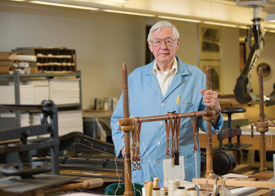Jim Craven recalls printing the notices heralding U-M’s historic 1955 Polio Vaccine Trial announcement at Rackham Auditorium.
“It’s hard to imagine what a hold that disease had on the community. It was something just to have been involved in that,” he says.

Jim Craven, conservator senior at the Bentley Historical Library, has worked at the university for 63 years. Photo by Scott C. Soderberg, Michigan Photography.
Involved since 1949 as a bookbinder and conservator at the university, Craven also is considered the longest serving U-M staff member ever, with more than 63 years on the job. His work has earned praise and was even deemed worthy of a museum exhibition.
Craven’s retirement will be marked with a Nov. 30 symposium from 3-4:30 p.m. at the Gerald Ford Library, followed by a reception from 4:30-6 p.m. at the Bentley Historical Library.
“Your work is that of a master craftsman,” wrote Francis X. Blouin Jr., Bentley director, in a recent letter honoring Craven. “Whether bookbinding, paper repair, box creation or any number of other projects, the work was always impeccable to the very highest standards, worthy of the great treasures entrusted to us by the various libraries at the university.”
Besides restoring and even rebuilding vintage books, Craven also is known among colleagues for some striking innovations. He and colleague Ann Flowers, associate archivist, developed a system to effectively dry restored pages by mounting them in a zigzag configuration using wooden frames, fish line and a fan. “It draws the air through gently,” Craven explains.
Flowers describes another “Jim invention” as the Craven Draft Indicator. The wind vane-like contraption of wood, wire and paper is placed in front of an air line, which draws away chemical fumes created during book restoration work. It shows the line is working properly.
In 1976, Craven decided that the library needed a disaster plan, an idea that was ahead of its time. While the idea was his, he assigned Flowers to develop the plan, one of the first for an archives.
Yet another Craven innovation was invaluable during the 1981 Economics Building fire. A disaster plan he developed included a provision to salvage wet paper, should it be doused in a fire. “One of the unique things was that it said books and papers we wanted to save could be boxed and frozen,” Flowers says. Craven had done research that showed that freezing and subsequent storage would allow moisture to slowly evaporate, avoiding water damage. The plan worked.
Craven’s first work at U-M actually began in 1947. While still in high school, he began working part time in the bookbindery in the Hatcher Graduate Library lower level. “I was just looking for a job; my father (George Craven) was a bookbinder,” he says. He began working full time in 1949, left in 1951 to serve in the Army in Korea and Japan, then returned to the bindery in 1953.
His main job was rebinding books and binding periodicals for the library. “I was working with some older people who were very, very good at what they did. We could get 100 years experience getting any two or three people together, some had trained in Europe and some had trained here,” he says.
Craven says key bookbinding skills are problem solving abilities, good hand-eye coordination, and some creativity. He became particularly adept at an important bookbinding skill, preparing leather for covers or bindings. “Leather has a thickness. Where it meets paper or piece of cloth you have to thin it at the edge so you don’t get a bump. You do that with a very sharp knife. You use a leather strop same as a barber would use when he’s shaving somebody. You work with the leather on a very flat piece of stone,” he says.
“He runs the knife like butter in repairing books. It’s a joy to watch Jim pare leather,” Flowers says.
One key aspect of bindery work focused on older and damaged books. Learning to restore them would serve him well, when the decision came down to turn most of the bindery work to private firms. “That changed it to my working with rare books entirely,” Craven says. He moved to the Michigan Historical Collections in 1972 in the Bentley Historical Library, and restored rare books mainly for the Clements Library, the Law Library and the Special Collections Library.
Craven has used gold leaf, silver stamping foil and silk among other materials to repair books using materials appropriate to the age of the book, including book bindings dating as far back as the 1300s. He has traveled to China and Ireland to learn and share techniques with other conservators. He also has taught more than 60 students in individual study programs. Craven says keys to being successful are having a light and understanding approach and patience.
“When you have a book in front of you that has lasted several hundred years and there are maybe three of them left, if you keep that in your mind, you can’t work on the book. There has to be a little lighter attitude, and you have to take your time,” he says.
Despite exploding technology that has produced the Kindle and other electronic book devices, Craven prefers paper, saying it is more permanent. “If you want to keep it, paperize it,” he says.
Craven says he appreciates the university for being such a dynamic place. Upon retiring, he plans to spend more time with his wife Adele Laporte, seven children, nine grandchildren and golden retriever Buddy Bounder.
“I’ve been coming to work ever since I was 16 years old. I think I’d like to roll over some morning and go back to sleep,” he says.

